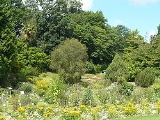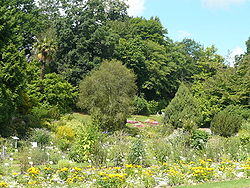
Jardin botanique de Caen
Encyclopedia

Botanical garden
A botanical garden The terms botanic and botanical, and garden or gardens are used more-or-less interchangeably, although the word botanic is generally reserved for the earlier, more traditional gardens. is a well-tended area displaying a wide range of plants labelled with their botanical names...
and arboretum
Arboretum
An arboretum in a narrow sense is a collection of trees only. Related collections include a fruticetum , and a viticetum, a collection of vines. More commonly, today, an arboretum is a botanical garden containing living collections of woody plants intended at least partly for scientific study...
located at 5, place Blot, Caen
Caen
Caen is a commune in northwestern France. It is the prefecture of the Calvados department and the capital of the Basse-Normandie region. It is located inland from the English Channel....
, Calvados
Calvados
The French department of Calvados is part of the region of Basse-Normandie in Normandy. It takes its name from a cluster of rocks off the English Channel coast...
, Basse-Normandie
Basse-Normandie
Lower Normandy is an administrative region of France. It was created in 1956, when the Normandy region was divided into Lower Normandy and Upper Normandy...
, France
France
The French Republic , The French Republic , The French Republic , (commonly known as France , is a unitary semi-presidential republic in Western Europe with several overseas territories and islands located on other continents and in the Indian, Pacific, and Atlantic oceans. Metropolitan France...
. It is open daily.
The garden's earliest plants were collected in 1689, and its first catalog published in 1781 (Jardin botanique de Caen by Farin and Demoneuse). It was established on the site of an old stone quarry as a university botanical garden, but in 1803, after the French Revolution
French Revolution
The French Revolution , sometimes distinguished as the 'Great French Revolution' , was a period of radical social and political upheaval in France and Europe. The absolute monarchy that had ruled France for centuries collapsed in three years...
, it was extended by 3.5 hectares to become a municipal park. In 1860 two large greenhouses were constructed, and a botanical institute added in 1891, but all were destroyed in World War II
World War II
World War II, or the Second World War , was a global conflict lasting from 1939 to 1945, involving most of the world's nations—including all of the great powers—eventually forming two opposing military alliances: the Allies and the Axis...
. New greenhouses were built in 1988.
Today the garden contains more than 8,000 species
Species
In biology, a species is one of the basic units of biological classification and a taxonomic rank. A species is often defined as a group of organisms capable of interbreeding and producing fertile offspring. While in many cases this definition is adequate, more precise or differing measures are...
laid out in two sections. The lower section contains native plants of Normandy
Normandy
Normandy is a geographical region corresponding to the former Duchy of Normandy. It is in France.The continental territory covers 30,627 km² and forms the preponderant part of Normandy and roughly 5% of the territory of France. It is divided for administrative purposes into two régions:...
(about 1,000 species), a medicinal garden (600 plants), horticultural collections (700 varieties), rockeries (1,500 dwarf specimens), an arboretum
Arboretum
An arboretum in a narrow sense is a collection of trees only. Related collections include a fruticetum , and a viticetum, a collection of vines. More commonly, today, an arboretum is a botanical garden containing living collections of woody plants intended at least partly for scientific study...
of trees and shrubs (500 species), and a greenhouse of about 1,500 exotic species. The upper section is a public park containing remarkable tree specimens including Sophora japonica (1750), Sequoiadendron giganteum (1890), and Cryptomeria japonica (1870).

